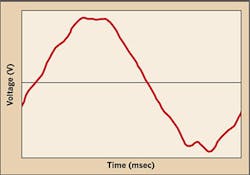Typically, harmonic distortion in the power supply isn’t addressed until it starts being suspected as a cause of equipment failure or downtime. Don’t be typical.
Suppose you have two 480V motor circuits, each supplying a different 400 HP motor. One of them has a variable frequency drive (VFD) that is harmonics corrected; the other runs across the line.
If you can use an infrared camera to compare the two circuits where the conductors leave their respective circuit breakers, you can identify which one has that harmonics-corrected VFD and which one does not. This heat is wasted energy.
How do you find harmonics? Using the infrared camera is not a conclusive means, because you could have excess heating for other reasons. Here are some other options you can use.
• A power monitor at the main switchboard is never a bad idea, especially if it includes specific loads such as your largest motors.
• A power analyzer is portable, and can be used at any point of the distribution system.
• A harmonic analyzer, which is made specifically for this purpose.
A good harmonic analyzer is easy to use and will show you graphically the breakdown of your component harmonics in addition to other information such as your Total Harmonic Distortion (THD). The component breakdown is essential if you want to understand your harmonic distortion picture.
One power quality consultant always starts by identifying the 5th harmonic and working out any problems there before addressing any other aspect of harmonics. His rationale for doing this it always produces an immediate measurable improvement.
In most situations, it’s not economically feasible to try to totally eliminate harmonics. You need a strategic approach in deciding which ones are worth curing, which ones are better served by coping techniques, and which ones are best ignored.
A good reference for getting a handle on harmonics is IEEE 519-2014, Recommended Practice and Requirements for Harmonic Control in Electrical Power Systems.
But what if your plant is one of those typical ones that doesn’t address harmonics until most other failure causes have been worked out? How do you persuade your management to pay for a harmonic analyzer? Especially if this all sounds like voodoo to them?
First, pick any critical load that probably has harmonics, such as the motor for a plant air compressor. Conduct a thermographic study on the motor and its supply. The graphical evidence here is almost always persuasive.
Second, measure the voltage using a true RMS digital multimeter (DMM) and then measure it with a DMM that is not true RMS. This second meter will probably be an inexpensive meter that uses the peak or average method. The bigger the difference between these two measurements, the more energy you are wasting because of harmonics. Use this number to quantify things.
Third, use some of the information in IEEE 519-2014 to bolster your case.
So now you have:
1. Convincing graphics.
2. Quantitative evidence.
3. An authoritative reference.
Once you have the tools for identifying where harmonics problems are and what they are, you’ll still have to make a case for the curing or coping projects required to address them. To keep the management support ball rolling, always include before and after data. Starting with a major harmonics problem rather than a small one will allow you to make the best initial impression as your program gets off the ground.
About the Author

Mark Lamendola
Mark is an expert in maintenance management, having racked up an impressive track record during his time working in the field. He also has extensive knowledge of, and practical expertise with, the National Electrical Code (NEC). Through his consulting business, he provides articles and training materials on electrical topics, specializing in making difficult subjects easy to understand and focusing on the practical aspects of electrical work.
Prior to starting his own business, Mark served as the Technical Editor on EC&M for six years, worked three years in nuclear maintenance, six years as a contract project engineer/project manager, three years as a systems engineer, and three years in plant maintenance management.
Mark earned an AAS degree from Rock Valley College, a BSEET from Columbia Pacific University, and an MBA from Lake Erie College. He’s also completed several related certifications over the years and even was formerly licensed as a Master Electrician. He is a Senior Member of the IEEE and past Chairman of the Kansas City Chapters of both the IEEE and the IEEE Computer Society. Mark also served as the program director for, a board member of, and webmaster of, the Midwest Chapter of the 7x24 Exchange. He has also held memberships with the following organizations: NETA, NFPA, International Association of Webmasters, and Institute of Certified Professional Managers.

